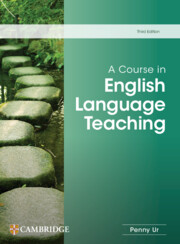Book contents
- Frontmatter
- Contents
- Acknowledgements
- Introduction
- 1 Teaching English today
- 2 The lesson
- 3 Classroom interaction
- 4 Tasks
- 5 Texts
- 6 Teaching vocabulary
- 7 Teaching grammar
- 8 Teaching listening
- 9 Teaching speaking
- 10 Teaching reading
- 11 Teaching writing
- 12 Feedback and error correction
- 13 Assessment and testing
- 14 The syllabus
- 15 Teaching/learning materials
- 16 Teaching content
- 17 Classroom discipline
- 18 Digital technology and online teaching
- 19 Learner differences 1: age
- 20 Learner differences 2: diversity and inclusion
- 21 Teacher development
- Glossary
- References
- Index
12 - Feedback and error correction
Published online by Cambridge University Press: 15 March 2024
- Frontmatter
- Contents
- Acknowledgements
- Introduction
- 1 Teaching English today
- 2 The lesson
- 3 Classroom interaction
- 4 Tasks
- 5 Texts
- 6 Teaching vocabulary
- 7 Teaching grammar
- 8 Teaching listening
- 9 Teaching speaking
- 10 Teaching reading
- 11 Teaching writing
- 12 Feedback and error correction
- 13 Assessment and testing
- 14 The syllabus
- 15 Teaching/learning materials
- 16 Teaching content
- 17 Classroom discipline
- 18 Digital technology and online teaching
- 19 Learner differences 1: age
- 20 Learner differences 2: diversity and inclusion
- 21 Teacher development
- Glossary
- References
- Index
Summary
Error correction: some basic issues
The term error correction
I am using the term error correction here in its conventional sense to refer to what a teacher does when indicating to the learner when they have said or written a form that is considered an error by the standards of acceptability of international English (see 1 Teaching English today) and helping them to correct it. Researchers mostly prefer to use the more precise term corrective feedback, since the word correction assumes that the error has in fact been corrected, whereas this is not necessarily the case: the learner may continue to make the error. In this book, I’ll use mostly the more common, conventional term error correction, while bearing in mind that such correction, from the learner's point of view, may be only temporary, or may not be perceived at all: the term refers primarily to the written or spoken input of the teacher.
Is error correction effective?
Most teachers assume that error correction is a natural and necessary component of the language teaching/learning process, as do students. However, there are some who cast doubts on its effectiveness (e.g., Truscott, 1999), based on the fact that learners often continue to make the same mistakes after being corrected (more on this below). Krashen (2002) says that error correction only helps conscious learning and does not have much lasting effect on permanent language acquisition. The general consensus today, however, is that error correction does contribute to proficiency (see, for example, the introduction to the collection of papers on the topic edited by Nassaji and Kartchava, 2021).
Do learner errors derive from L1 interference?
In learning their first language, learners have no competing language, and their mistakes therefore will be a result of what they know, or don't know, of the language so far. For example, they may over-generalize rules (e.g., *goed instead of went). As they hear the correct forms more and more, these will naturally take over, and conscious correction is not necessary (although it is sometimes supplied by, for example, parents talking to their children).
- Type
- Chapter
- Information
- A Course in English Language Teaching , pp. 163 - 175Publisher: Cambridge University PressPrint publication year: 2024

